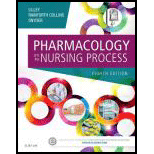
To discuss:
The normal physiology, anatomy, and related functions of the adrenal glands, including the specific hormones that are released from the glands.
Introduction:
The adrenal glands are the endocrine glands that synthesize a variety of hormones. It is located above each kidney like a cap. It is also called suprarenal glands.
Explanation of Solution
The adrenal gland is made up of two distinct parts, namely the adrenal medulla and adrenal cortex. They functionally and structurally differ from each other. The adrenal cortex is the outer layer and is made up of endocrine tissues. The adrenal medulla is the inner layer and is made up of both the endocrine and neurosecretory tissues. Each adrenal gland secretes two different hormones.
The hormones secreted by the adrenal cortex are also referred to as corticosteroids as it has the chemical structure of steroids. The corticosteroids are of two types, namely glucocorticoids and mineralocorticoids. The regulation of electrolytes in the body is carried out by the mineralocorticoids. It maintains the sodium homeostasis in the blood. It also influences the potassium and pH levels of the blood. It controls the blood pressure. The glucocorticoids affect the
The hormones secreted by the adrenal medulla are epinephrine and norepinephrine. They are referred to as catecholamines. Epinephrine is also known as adrenaline. It is an emotion causing hormone. It increases the muscle strength, heart rate, blood pressure, and sugar metabolism. Norepinephrine is also known as noradrenaline. During rest, it increases the blood pressure and heart rate of the body, increases the blood flow to the muscles, and decreases the blood flow the GI system.
The anatomy, functions, and physiology including the hormones secreted by the adrenal glands are discussed.
Want to see more full solutions like this?
Chapter 33 Solutions
Pharmacology and the Nursing Process, 8e
- true or false any practice employee is authorized to and should communicate collection guidelines with practice?arrow_forwardrtrue or false equesting a listing of specific creditreferences during patient intake os an acceptable business practice?arrow_forwardgive an overview on the respiratory assessmentarrow_forward
- explain an abdominal exam?arrow_forwardDiscuss β -Lactam antibiotics under the following subheadings Classifications of penicillins Classification of Cephalosporins General Mechanism of Actions Clinical Indications of penicillins and cephalosporins Adverse effects of β-lactamsarrow_forwarda. Define neoplasm b. Differentiate between benign and malignant tumours c. Describe the molecular basis of cancerarrow_forward
- differentiate the extra heart sounds S3,S4, murmurs and gallopsarrow_forward• Define shock and list types of shock • Discuss pathogenesis of septic shock. • Enumerate the stages of shock. • Define oedema and describe the pathophysiologic mechanisms of oedema with examples.arrow_forwardDiscuss Hypertension under the following headings: Definition Diagnosis Non-pharmacological intervention Drugs Classification Management of a Hypertensive emergencyarrow_forward
- Explain how the answer could be 2 or 1.8 WITHOUT changing the questionarrow_forwardoverview of the neurological system, cranial nerves and what part of the body it innervatesarrow_forwarddifferentiate structure and function of the peripheral vascular system. what are the normal and abnormal findings of the peripheral arterioles and peripheral venous systemarrow_forward
 Phlebotomy EssentialsNursingISBN:9781451194524Author:Ruth McCall, Cathee M. Tankersley MT(ASCP)Publisher:JONES+BARTLETT PUBLISHERS, INC.
Phlebotomy EssentialsNursingISBN:9781451194524Author:Ruth McCall, Cathee M. Tankersley MT(ASCP)Publisher:JONES+BARTLETT PUBLISHERS, INC. Gould's Pathophysiology for the Health Profession...NursingISBN:9780323414425Author:Robert J Hubert BSPublisher:Saunders
Gould's Pathophysiology for the Health Profession...NursingISBN:9780323414425Author:Robert J Hubert BSPublisher:Saunders Fundamentals Of NursingNursingISBN:9781496362179Author:Taylor, Carol (carol R.), LYNN, Pamela (pamela Barbara), Bartlett, Jennifer L.Publisher:Wolters Kluwer,
Fundamentals Of NursingNursingISBN:9781496362179Author:Taylor, Carol (carol R.), LYNN, Pamela (pamela Barbara), Bartlett, Jennifer L.Publisher:Wolters Kluwer, Fundamentals of Nursing, 9eNursingISBN:9780323327404Author:Patricia A. Potter RN MSN PhD FAAN, Anne Griffin Perry RN EdD FAAN, Patricia Stockert RN BSN MS PhD, Amy Hall RN BSN MS PhD CNEPublisher:Elsevier Science
Fundamentals of Nursing, 9eNursingISBN:9780323327404Author:Patricia A. Potter RN MSN PhD FAAN, Anne Griffin Perry RN EdD FAAN, Patricia Stockert RN BSN MS PhD, Amy Hall RN BSN MS PhD CNEPublisher:Elsevier Science Study Guide for Gould's Pathophysiology for the H...NursingISBN:9780323414142Author:Hubert BS, Robert J; VanMeter PhD, Karin C.Publisher:Saunders
Study Guide for Gould's Pathophysiology for the H...NursingISBN:9780323414142Author:Hubert BS, Robert J; VanMeter PhD, Karin C.Publisher:Saunders Issues and Ethics in the Helping Professions (Min...NursingISBN:9781337406291Author:Gerald Corey, Marianne Schneider Corey, Cindy CoreyPublisher:Cengage Learning
Issues and Ethics in the Helping Professions (Min...NursingISBN:9781337406291Author:Gerald Corey, Marianne Schneider Corey, Cindy CoreyPublisher:Cengage Learning





